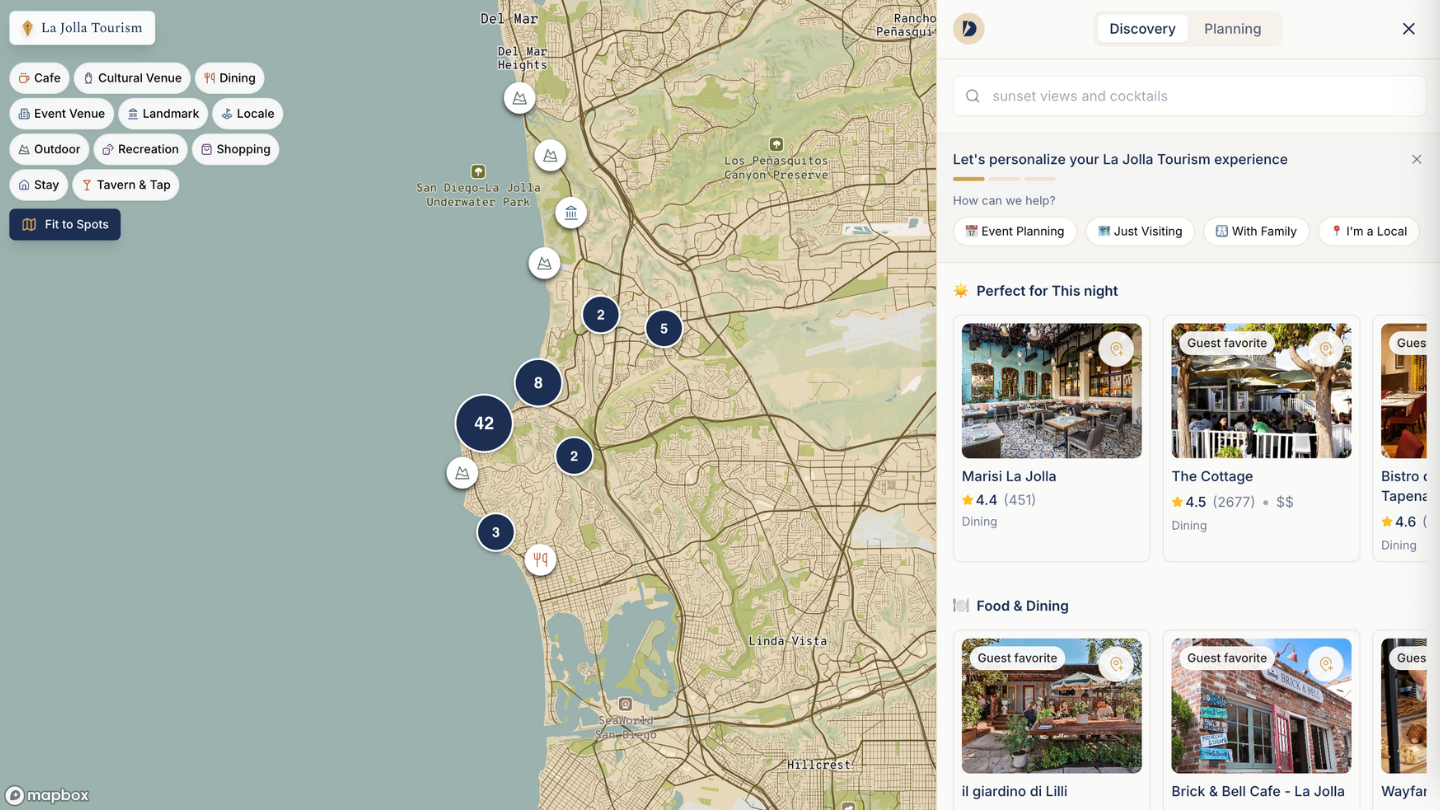
AI in Attribution Models for Tourism Marketing
Aaron
about 2 months ago
AI is transforming how tourism marketers measure success. Traditional attribution models often fail to track the complex paths travelers take before booking a trip. AI-powered attribution models solve this by analyzing millions of customer interactions, assigning credit to marketing touchpoints more accurately, and even predicting future behavior.
Here’s why this matters for Destination Marketing Organizations (DMOs):
• Better Budget Allocation: AI identifies high-performing channels, ensuring marketing dollars are spent wisely.
• Personalized Campaigns: Insights into traveler behavior allow for tailored marketing strategies.
• Improved ROI: AI tracks meaningful outcomes like bookings, repeat visits, and referrals, not just clicks.
AI models like Markov Chains and Shapley Value go beyond simple first- or last-touch methods. They analyze complex patterns, track cross-device journeys, and adapt dynamically to changing traveler behavior. Tools like Drifter AI provide real-time metrics and partner referral tracking, helping DMOs boost engagement and support local businesses.
As travel planning becomes increasingly digital, AI attribution is no longer optional - it’s essential for staying competitive.
How Attribution Models Have Changed in Tourism Marketing
The way attribution models are used in tourism marketing has come a long way, mirroring the industry's growing ability to understand and predict customer behavior. What started with basic, one-dimensional systems has evolved into advanced, AI-powered tools capable of analyzing millions of interactions across a variety of channels.
From Simple to Advanced Attribution Models
Early attribution models were basic but came with serious limitations. For instance, first-touch attribution gave all the credit to the first interaction a customer had with a brand, while last-touch attribution focused solely on the final step before a booking. There was also linear attribution, which evenly distributed credit across all touchpoints. While these methods were easy to implement, they didn’t reflect the reality of how people make travel decisions. For example, a traveler might explore destinations on Pinterest, compare hotel prices on multiple websites, read reviews, and then finalize the booking through an agent. These models either gave all the credit to a single step or treated every interaction as equally important - neither approach captured the full picture.
Some improvements came with time-decay attribution, which placed more weight on recent interactions, and position-based attribution, which prioritized the first and last touchpoints. However, these models still relied on fixed rules rather than adapting to real customer behavior.
As digital marketing expanded to include social media, search engines, email campaigns, influencer collaborations, and offline channels, these rigid models started to show their age. Tourism marketers needed tools that could identify which combinations of touchpoints actually drove bookings. The inability of rule-based models to adapt to shifting traveler preferences or seasonal trends paved the way for AI-driven solutions.
How AI Improves Modern Attribution Models
AI has completely reshaped attribution models by replacing static rules with machine learning algorithms that adapt to real customer behavior. These systems process data in real time, identify which prospects are most likely to book, and adjust models dynamically as new information comes in. This allows tourism marketers to tweak their strategies during live campaigns instead of waiting for post-campaign reports.
AI’s predictive capabilities are a game-changer. Destination marketing organizations (DMOs) can now personalize their efforts at every stage of the travel journey. AI excels at tracking interactions across devices - whether someone is researching on their phone, comparing options on a tablet, or making the final booking on a desktop. This creates a complete, unified view of the customer journey.
Unlike traditional methods, AI-powered attribution models can analyze complex patterns and subtle combinations of interactions. Machine learning algorithms assign credit based on the actual contribution of each touchpoint, examining thousands of customer journeys to pinpoint the key drivers of bookings. These models adapt automatically to changing behaviors, eliminating the need for manual adjustments.
This shift to AI-driven attribution empowers tourism marketers to make smarter decisions about where to allocate budgets, how to optimize channels, and how to refine campaign strategies. By replacing guesswork with data-backed insights, DMOs can engage travelers more effectively and allocate resources more efficiently - critical for navigating the multi-stage decision-making process that defines modern travel planning.
Types of AI Attribution Models and How They Work
AI takes traditional attribution models to the next level by breaking down customer interactions into measurable segments. It processes large data sets, adapts to shifting customer behavior, and evolves alongside new information. Below, we’ll explore how AI refines traditional attribution methods and introduces more advanced approaches.
AI-Enhanced First-Touch and Last-Touch Attribution
First-touch and last-touch attribution models have long been used to track customer interactions, but they’ve often been too simplistic. AI changes the game by analyzing the quality of engagement at each touchpoint. For example, instead of merely recording a visitor’s first interaction with a website, AI examines whether that visit signals casual browsing or serious purchase intent. Metrics like time spent on-site and the number of pages viewed help paint a clearer picture.
Similarly, AI-powered last-touch attribution doesn’t stop at the final click. It digs deeper into the broader context of the customer journey, offering a more complete understanding of how the final interaction fits into the overall conversion process.
Multi-Touch Attribution with AI
AI-driven multi-touch attribution models are a step up from traditional linear or time-decay approaches. These models use machine learning to analyze countless customer journeys, identifying which sequences of interactions lead to conversions. Instead of relying on fixed rules, AI assigns dynamic credit to different channels and continuously refines its analysis. Another advantage? AI enables unified tracking across devices, giving marketers a clearer view of how customers interact with their brand.
Advanced AI Attribution Models
For organizations ready to go beyond the basics, advanced AI models provide even more precise insights into how each touchpoint contributes to conversions.
• Markov Chain Models: These models treat the customer journey as a series of states, analyzing the likelihood of transitions between touchpoints. In the tourism industry, this helps identify the most effective sequences of interactions that lead to bookings.
• Shapley Value Attribution: Borrowed from game theory, this method evaluates the contribution of each touchpoint by analyzing all possible combinations of interactions. It’s particularly useful for understanding the marginal impact of individual marketing channels.
• Machine Learning Ensemble Models: These combine multiple techniques - like neural networks, decision trees, and regression models - to capture complex patterns and account for external factors such as seasonality or economic trends. Some even incorporate external data like weather conditions or local events for a more nuanced analysis.
AI Attribution in Action: Tourism Marketing Examples
AI-powered attribution methods have reshaped how tourism marketing organizations measure success and refine campaigns. With 54% of Destination Marketing Organizations (DMOs) struggling to prove ROI, the gap between marketing budgets and measurable outcomes has become a pressing issue. To tackle this, many DMOs are turning to AI solutions that provide clearer insights into campaign performance. These systems can distinguish between casual website visitors and serious trip planners by analyzing specific engagement behaviors. Let’s explore how these advancements, including Drifter AI, are making a difference.
Case Studies and Research Results
Tourism marketing organizations adopting AI attribution systems have seen noticeable improvements. Advanced AI models analyze visitor behavior in detail, identifying high-intent users who are more likely to convert. This allows DMOs to focus their resources where they matter most. As a result, organizations report more accurate budget allocation and greater confidence from stakeholders in their marketing investments.
Drifter AI's Attribution Features

Drifter AI offers tools designed specifically for DMOs, including partner referral tracking. This feature monitors clicks on hotels and attractions, quantifying the value generated for local businesses and stakeholders.
The platform’s analytics dashboard provides real-time tracking of key metrics like trip creation data, visitor flow patterns, search queries, and session durations. These insights help DMOs understand visitor behavior and campaign performance instantly.
One standout feature of Drifter AI is its ability to dramatically boost visitor engagement. The platform extends average engagement times from less than 30 seconds to over 15 minutes of trip planning. This deeper engagement generates richer data for attribution analysis, leveraging features like Smart Discovery, Intelligent Itinerary Building, and Natural Language Search.
First-Party Data and Privacy Compliance
AI attribution also relies on robust first-party data strategies to ensure both accuracy and compliance with U.S. privacy standards. Visitors share data through AI-powered trip planning tools, enabling DMOs to build precise attribution models while respecting privacy regulations.
This approach enhances transparency and helps predict conversions and campaign effectiveness. DMOs report increased stakeholder confidence, as they can justify their marketing budgets and demonstrate economic impact more effectively. With privacy regulations evolving, organizations equipped with strong first-party data strategies are better positioned to measure and optimize their campaigns.
Best Practices and Future Trends for AI Attribution
To successfully implement AI attribution, focus on connecting data, training your team, testing on a smaller scale, and setting clear measurement objectives.
How to Implement AI Attribution Models
Start with data integration, which is key to creating a unified view of your marketing efforts. This means linking all your channels - social media, email campaigns, paid ads, and website interactions - into one system that tracks visitor journeys across multiple touchpoints.
Next, train your team to interpret AI-driven insights and understand how these models differ from traditional attribution methods. This includes learning about concepts like attribution weights, the influence of one channel on another, and predictive scoring.
Use pilot programs to test AI attribution on a smaller scale before rolling it out fully. For instance, Drifter AI offers pilot programs tailored for DMOs (Destination Marketing Organizations), helping them assess how the platform impacts their marketing mix and visitor behavior.
Finally, set clear goals and measurement standards. Define baseline metrics, establish consistent reporting structures, and ensure stakeholders can easily interpret the data to make informed decisions.
Once you've laid the groundwork, be prepared to tackle common challenges that may arise.
Common Challenges and Solutions
One major hurdle is data quality. Issues like inconsistent tracking codes, missing data, or fragmented visitor journeys can compromise the accuracy of your attribution models. Conduct thorough data audits beforehand and implement standardized tracking protocols to avoid these pitfalls.
Another challenge is cross-channel integration. Different platforms often use incompatible data formats, making it difficult to unify everything. Look for attribution tools with strong API connections that can normalize data from various sources into a consistent format.
While AI provides powerful insights, don’t overlook the value of human judgment. AI can identify patterns and process vast datasets, but your team still needs to provide strategic context and make key decisions about budget allocation and campaign adjustments.
Lastly, budget constraints can limit access to advanced tools. However, platforms like Drifter AI offer flexible pricing models designed to fit DMO fiscal years, making these tools more accessible to organizations with varying budgets.
Future Trends in AI Tourism Marketing
Looking ahead, AI is poised to transform tourism marketing in several exciting ways.
AI will enable hyper-personalization by predicting visitor preferences in real time. This allows DMOs to deliver tailored content and recommendations based on individual engagement patterns and micro-interactions.
Expect a shift to real-time performance optimization, where AI attribution systems automatically adjust marketing spend and messaging based on live performance data. This means DMOs can respond instantly to changes in market conditions or visitor behavior.
Predictive analytics will become more advanced, forecasting not only individual visitor actions but also broader trends and seasonal patterns. These insights will help DMOs plan campaigns months in advance and allocate resources more effectively.
As data privacy regulations evolve, privacy-first attribution models will gain prominence. Future systems will rely more on first-party data and privacy-compliant tracking methods, ensuring accurate measurement while respecting user privacy.
The rise of voice search and conversational AI will also play a role. As travelers increasingly use voice assistants and natural language search to plan trips, DMOs will gain deeper insights into visitor intent and decision-making processes.
Conclusion: Why AI Attribution Matters for Tourism
AI attribution models have become a game-changer for Destination Marketing Organizations (DMOs) navigating today’s complex digital world. On average, travelers visit 38 websites before making a booking decision. This behavior underscores how intricate customer journeys can be, often leaving traditional attribution models struggling to keep up.
Post-COVID-19, 90% of travel marketers are working with reduced budgets. In this environment, every dollar matters. AI attribution helps DMOs pinpoint the touchpoints that genuinely drive conversions, allowing for smarter budget allocation and better returns on investment. This precision is especially critical when you consider that 69% of customers are more loyal to travel companies that provide personalized experiences. By focusing on ROI, DMOs can craft engagement strategies that resonate with their audiences.
"Attribution in the tourism industry is not just a buzzword; it's an urgent necessity." - Wizaly
Personalized engagement is at the heart of this approach. AI attribution uncovers visitor preferences and behaviors across channels, enabling DMOs to create targeted promotions that boost re-engagement. This is particularly vital for attracting younger travelers, as 80% of millennials are inspired to travel by content shared by peers and travel brands.
Beyond improving marketing strategies, accurate attribution directly supports local businesses. AI-powered insights help optimize campaigns that drive foot traffic, bookings, and revenue for local partners. Tools like Drifter AI take this a step further by combining partner referral tracking with AI-driven trip planning, creating a win-win for both visitors and local economies.
The importance of attribution is clear: a 2019 QueryClick survey found that nearly 90% of marketers hesitate to invest in long-term projects without reliable attribution data. AI models address this challenge by delivering actionable insights that track the entire visitor journey, proving the value of marketing efforts.
Adopting AI attribution isn’t just about keeping up; it’s about thriving. These tools empower DMOs to make better financial decisions, deliver more personalized travel experiences, and strengthen local economies. As competition in the tourism industry intensifies, the real question is no longer if organizations should adopt AI attribution, but how quickly they can implement it to stay ahead.
FAQs
How are AI-driven attribution models changing the way customer journeys are tracked in tourism marketing?
AI-powered attribution models are changing the game for tracking customer journeys. By leveraging machine learning, these models dive deep into complex, multi-channel behaviors. Unlike traditional methods - like first-touch or last-touch attribution, which stick to rigid rules - AI considers a wide range of factors, such as customer behavior, context, and interactions across various platforms.
This advanced approach paints a clearer picture of how different touchpoints influence conversions. For tourism marketers, this means smarter budget allocation and the ability to fine-tune campaigns to connect with travelers at just the right moments. With these insights, Destination Marketing Organizations (DMOs) can make informed decisions that not only support local businesses but also enhance the overall visitor experience.
What are the main benefits of using AI-powered attribution models for Destination Marketing Organizations (DMOs)?
AI-driven attribution models give Destination Marketing Organizations (DMOs) a clear picture of how their marketing channels are performing. With this level of insight, DMOs can allocate their resources wisely and make more informed budgeting choices.
These models also provide real-time analysis that can easily adapt to different campaign needs, enabling DMOs to adjust strategies on the fly and enhance visitor engagement. By tapping into AI, DMOs can access valuable data to refine their marketing efforts and showcase measurable returns on investment (ROI).
What obstacles do DMOs face when using AI for attribution models, and how can they address them?
DMOs face several hurdles, including understanding the complexity of how travelers make decisions, dealing with gaps in tracking data caused by technological limitations, and navigating the risk of AI inaccuracies that can distort attribution results. These challenges can undermine the reliability of insights and reduce the impact of marketing efforts.
To tackle these issues, DMOs should consider using advanced AI tools capable of processing real-time data. Regularly validating attribution models and offering ongoing training for staff are also key steps. By educating teams about both the strengths and limitations of AI, organizations can ensure smarter usage and more precise results. Taking these measures allows DMOs to harness the benefits of AI-driven attribution while reducing potential risks.
About Aaron
Founder @ Drifter AI
AI Trip Planning Widget for Tourism Websites
Increase visitor engagement by 67% with Drifter AI's personalized trip planner. Purpose-built destination marketing software that converts website visitors into actual travelers.
Prove Your Worth
Track engagement and partner referrals to show stakeholders your direct impact on tourism
Support Partners
Monitor clicks to hotels, restaurants, and attractions - prove your value to local businesses
No IT Needed
One line of code works with Simpleview, WordPress, or any website platform
Related Dispatches

How AI Enhances Partner Referral Tracking
Discover how AI automates partner referral tracking and boosts accuracy. Start optimizing your DMO partnerships with real-time insights today!

Common Challenges in AI Content Personalization
Boost engagement with AI content personalization while tackling privacy, segmentation, and scaling issues. Learn effective strategies and solutions now.

Real-Time Event Data for DMOs
Unlock real-time event insights for DMOs to enhance visitor experience and measure impact. Discover smart analytics and AI tools. Start optimizing today!